Religion in Brazil
Religion in Brazil (2010 census)[1][2]
Religion in Brazil (2020 estimate)[3]

| Religion by country |
|---|
|
|
| Part of a series on the |
| Culture of Brazil |
|---|
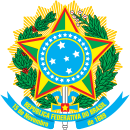 |
| Society |
| Topics |
| Symbols |
The predominant religion in Brazil is Christianity, with Catholicism being its largest denomination.
In 1891, when the first Brazilian Republican Constitution was set forth, Brazil ceased to have an official religion and has remained secular ever since, though the Catholic Church remained politically influential into the 1970s. The Constitution of Brazil guarantees freedom of religion and strongly prohibits the establishment of any religion by banning government support or hindrance of religion at all levels.[4]
Overview
[edit]Brazil possesses a richly spiritual society formed from the meeting of the Catholic Church with the religious traditions of enslaved Africans and indigenous people. This confluence of faiths during the Portuguese colonization of Brazil led to the development of a diverse array of syncretistic practices within the overarching umbrella of Brazilian Catholicism, characterized by traditional Portuguese festivities.[4] Until recently Catholicism was overwhelmingly dominant. Changes in the 21st century have led to a growth in secularism (no religious affiliation) and to Evangelical Protestantism, at 31% of the population. A 2020 poll indicates that around 50% of Brazilians consider themselves Catholic, down from 90% in 1970.[5] Despite falling in most of the country, Catholicism remains strong in most of the Northeast.[6][7][8][9] Some analysts have projected Protestants to possibly outnumber Catholics around 2030, with the Catholic Church membership dropping to 38.6%, the Protestant membership in hundreds of independent denominations rising to 39.8%, and the non-Christian population (including the non-affiliated) rising to over 20%.[8][9] In the 2010 census,[1] 64.63% of the population declared themselves as Catholic, 22.2% as Protestant, 8% as non-religious, and 5.2% as followers of other religions (mostly Spiritists or Kardecists who follow the doctrines of Allan Kardec, Umbandists, Candomblers, Jehovah's Witnesses, The Church of Jesus Christ of Latter-day Saints, and minorities of Buddhists, Jews, Muslims, and other groups).
Brazilian religions are very diversified and inclined to syncretism. In recent decades, there has been a great increase of Neo-Pentecostal churches and in Afro-Brazilian religions,[10] which has decreased the number of members of the Roman Catholic Church.[11] The number of Umbandists and Candomblers could be significantly higher than the official census figure since many of them continue to this day to disguise their religion under "Catholic" syncretism.[12] About ninety percent of Brazilians declared some sort of religious affiliation in the most recent census.[13]
Although the Federal Constitution guarantees religious tolerance to all its citizens (see article 5, item VI), it expressly prohibits all entities that make up the Federation to found and finance public cults and state churches controlled and coordinated by the Government - (see article 19, I), since until now the Brazilian State recognizes the "peculiar character" of the Catholic Church under the other religions in its legal system (see Article 16 of Decree 7107/2010), which is why the law recognizes the Virgin Mary, the mother of Jesus, as the "patroness of Brazil" (see Article 1 of Law 6,802 / 1980); the Constitution is sworn "under the protection of God" (see Preamble of the Federal Constitution); Catholic holidays (such as the day of Our Lady of Aparecida and the day of Our Lord's birth) are recognized as national holidays by law (see Law 10.607 / 2002, Law 6.802 / 1980); the Catholic religion has an exclusive Law regulating its relationship with the State (see Decree 7107/2010); cities and states bear the name of Catholic saints; Catholic statues are exposed in public offices; the expression "God be praised" is present in all real notes; and religious teaching exclusively Catholic in public schools is permitted in the country (see ADI 4439).[citation needed]
Religious intolerance is a crime in Brazil, and several laws ensure freedom of worship and protection for those who profess their faith. The Federal Constitution of 1988 (Arti.5, Clause IV) guarantees that "freedom of conscience and belief is inviolable, ensuring the free exercise of religious cults and guaranteeing, in accordance with the law, the protection of places of worship and their liturgies."[14]
The Brazilian Penal Code (Decree-Law 2,848/1940), establishes as a crime the act of "publicly mock someone based on their beliefs or religious function, stop or disturb a religious ceremony or practice, or publicly disrespect acts or objects of religious worship." The penalty for these acts is imprisonment for one month to one year or a fine. Law n. 14.532/2023 added paragraph three to Article 140 of the Penal Code, which determines that, in the case of the crime of insult, if it consists of elements related to religion or the condition of an elderly or disabled person, the penalty for the crime will be imprisonment for one to three years and a fine.
Demographics
[edit]2010 Census:[1]
- Christianity: 169,329,176 - 88.77%
- Roman Catholicism: 123,280,172 - 64.63%
- Protestantism: 42,275,440 - 22.16%
- Other Christians: 3,773,564 - 1.98%
- No religion: 15,335,510 - 8.04%
- Other religions: 6,091,113 - 3.19%
Christianity
[edit]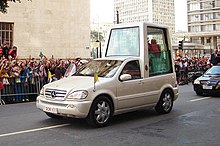

Catholicism
[edit]
Brazil has the largest number of Catholics in the world.[15] Catholicism has been Brazil's main religion since the beginning of the 16th century. It was introduced among the Native Brazilians by Jesuits [[Missionary|missionar colonial times, there was no freedom of religion. All Portuguese settlers and Brazilians were compulsorily bound to the Catholic faith and were bound to pay tithes to the church. After Brazilian independence, the first constitution introduced freedom of religion in 1824, but Catholicism was kept as the official religion. The Imperial Government paid a salary to Catholic priests and influenced the appointment of bishops. The political-administrative division of the municipalities accompanied the hierarchical division of the bishoprics in "freguesias" (parishes). There was also some hindrances to the construction of temples and cemeteries that belonged to the Catholic Church. The first Republican Constitution in 1891 separated religion from state and made all religions equal in the Codes of Law, but the Catholic Church remained very influential until the 1970s. For example, due to the strong opposition of the Catholic Church, divorce was not allowed in Brazil until 1977 even if a separated couple observed a different religion.
The Catholic faith practiced in Brazil is full of popular festivities rooted in centuries-old Portuguese traditions, but also heavily influenced by African and Native Brazilian usage. Popular traditions include pilgrimages to the National Shrine of Our Lady of Aparecida (Nossa Senhora Aparecida), the patron saint of Brazil, and religious festivals like the "Círio de Nazaré" in Belém and the "Festa do Divino" in many cities of Central Brazil. Areas that received many European immigrants in the last century, especially Italian and German, have Catholic traditions closer to that practiced in Europe.
The largest proportion of Catholics is concentrated in the Northeast (59%) and South (53%) regions. The smallest proportion of Catholics is found in the Center-West region (49%). The State of Piauí has the largest proportion of Catholics (85%) and the State of Rio de Janeiro has the smallest one (45.19%). Among the state capitals, Teresina has the largest proportion of Catholics in the country (86.010%), followed by Aracaju, Fortaleza, Florianópolis and João Pessoa.[16][17]
Alternatively, in the 20th century, former Catholic bishop Carlos Duarte Costa founded the Brazilian Catholic Apostolic Church after disagreements with clerical celibacy and other doctrines.
Protestantism
[edit]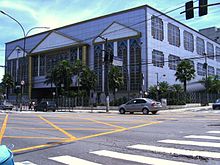
Protestantism in Brazil largely originated with American missionaries in the second half of the 19th century, following up on efforts that began in the 1830s. Evangelical Protestantism and Pentecostalism has grown very rapidly in Brazil since the late 20th century.[18] The 2010 Census reported that 22.2% of the Brazilian population is Protestant, about 44 million people. Brazil has many versions of Protestantism. These include neo-Pentecostals, old Pentecostals, and Traditional Protestants (most of them Baptists, Presbyterians and Methodists) predominantly from Minas Gerais to the South. The Anglican Episcopal Church of Brazil, part of the Anglican Communion, has some 120,000 members. Centers of neo-Pentecostalism are Londrina in Paraná state, as well the cities of São Paulo, Rio de Janeiro and Belo Horizonte (capital of Minas Gerais), especially the suburban and nearby areas of these cities. Lutherans are concentrated mostly in the states of Rio Grande do Sul, Santa Catarina and in countryside regions of the states of Rio de Janeiro and Espírito Santo.
As of the year 2000, the largest proportion of Protestants was found in North (19.8%), Central-West (18.9%) and Southeast (17.5%) regions. Among the state capitals, Rio de Janeiro has the largest proportion of non-Pentecostal Protestants in the country (10.07%), followed by Vitória, Porto Velho, Cuiabá and Manaus. But Goiânia is the state capital with the largest proportion of Pentecostal Protestants in the country (20.41%), followed by Boa Vista, Porto Velho, Belém and Belo Horizonte.[19][20] A 2023 IPSOS survey found that 38% of Brazilians identified as Catholic and 29% as Protestant.[21]
Orthodoxy
[edit]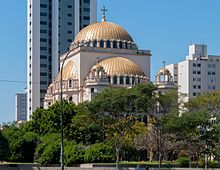
The Eastern Orthodox Church is also present in Brazil. The Orthodox Metropolitan Cathedral, located in São Paulo, is the See of the Archdiocese of the Greek Orthodox Church of Antioch in São Paulo. It is an example of Byzantine architecture that can be appreciated in South America. Its construction, which began in the 1940s, was inspired by the Basilica of Hagia Sophia of Istanbul and was inaugurated in January 1954. According to IBGE, there were 131,571 Orthodox Christians in Brazil.[1]
Jehovah's Witnesses
[edit]In 2022, according to the denomination, Brazil had 909,879 Jehovah's Witnesses with 12,439 congregations and a ratio of 1 Witness to 238 residents.[22] However, the 2010 census reported nearly 1.4 million people listed themselves as members.[1]
The Church of Jesus Christ of Latter-day Saints
[edit]The Latter-day Saints arrived in Brazil in 1913 through German immigrants,[23] but proselytizing efforts only began in 1929. It is the fastest-growing church in Brazil in terms of membership.[24] According to the religious institution's records, it has about 1.5 million members,[25] making Brazil the third country in the world with the most members, behind only the United States and Mexico. The Church has 36 missions, 2,172 congregations, 21 temples, and 524 Family History Centers.[26][27]
According to the Church's doctrine, these temples perform sacred ordinances such as vicarious baptism, celestial marriage, and family sealing, in addition to being places of learning and spirituality.[28] Only baptized and worthy members are allowed to enter the temples.[29] The Church also holds worship meetings on Sundays in its chapels throughout Brazil, which are open to the public.[30][31]
The Church is active in community assistance in Brazil, notably through the "Helping Hands" program. This initiative mobilizes members and volunteers in activities such as blood donation, food drives, support for natural disasters, health and education campaigns, and revitalization of public spaces. The church undertakes these actions to contribute to the well-being of its members and local communities.[32][33]
Despite being Christians, they believe themselves to be the restored Church of Christ on Earth.[34] Therefore, they are part of the Restorationist branch[35][36] and not affiliated with any other traditional religious movements such as Catholicism, Protestantism, Spiritism, or other Christian denominations, although they respect all denominations.[37][38]
Non-Christian religions
[edit]There are small populations of people professing Buddhism (215,000), Judaism (107,000), Islam (35,000), Shinto, Rastafari and many other religions. They comprise 21st century immigrants from East Asia, the Middle East, or of recent immigrant descent.
African and indigenous religions
[edit]
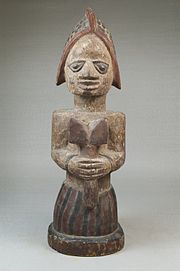
Afro-Brazilian religions are syncretic religions, such as Candomblé, that have many followers, mainly Afro-Brazilians. They are concentrated mainly in large urban centers in the Northeast, such as Salvador, Recife, or Rio de Janeiro in the Southeast. The cities of São Paulo, Porto Alegre and Florianópolis have a great number of followers, but in the South of Brazil the most common African influenced Ritual is Almas e Angola, which is an Umbanda like a ritual. Nowadays, there are over 70 "terreiros" (temples) in Florianópolis, which are the places where the rituals run. In addition to Candomblé which arose through a process of syncretism between several of the traditional religions of West Africa, especially that of the Yoruba, and the Roman Catholic form of Christianity, there is also Umbanda, a syncretic Brazilian religion that blends African traditions with Roman Catholicism, Spiritism, and Indigenous American beliefs. There are also Catholics, Protestants, and other kinds of Christians who hold a dual belief system and go to both churches and terreiros.
Candomblé, Umbanda, Batuque, Xango, and Tambor de Mina are Afro-Brazilian religions influenced by the native cults brought by black slaves shipped from Africa to Brazil. These black slaves would summon their gods, called Orixas, Voduns, or Inkices with chants and dances they had brought from Africa. These cults were persecuted throughout most of Brazilian history,[citation needed] largely because they were believed to be pagan or even satanic. However, the Brazilian republic government legalized all of them on the grounds of the necessary separation between the State and the Church in 1889.
In current practice, Umbanda followers leave offerings of food, candles, and flowers in public places for the spirits. Candomblé terreiros have similar practices, and there are a number of festivals that occur yearly especially in the Northeast, with celebrations such as the famous Iyemanja Festival and the Waters of Oxala.
From Bahia northwards there are different practices such as Catimbo, and Jurema with heavy indigenous elements. All over the country, but mainly in the Amazon rainforest, there are many Indians still practicing their original traditions. Many of their beliefs and use of naturally occurring plant derivatives are incorporated into African, Spiritualists, and folk religions.
These religions have suffered increasing hostility from Protestant churches, with attacks on temples and the defacement of statues of the gods.[39][40] In recent years measures have been taken to counter religious conflict.[39]
Spiritism
[edit]
Spiritism is a religion, founded in the 19th century by the French educator Allan Kardec, which proposes the study of "the nature, origin, and destiny of spirits, and their relation with the corporeal world".[41] Spiritism follows Jesus's moral teachings, and therefore its status as a non-Christian religion is an object of debate between its followers and mainstream Christians. If considered non-Christian, Spiritism would be by far the largest non-Christian religion in Brazil; if considered as a Christian religion, it would be the third largest denomination after Roman Catholicism and the Protestant Assemblies of God. [citation needed] It studies topics such as life after death, reincarnation, spirits, moral teachings and much more.
Buddhism
[edit]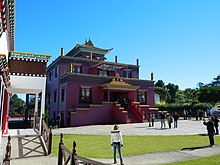
Buddhism is probably the largest of all minority religions, with about 215,000 followers. Brazil is home to the third-largest Buddhist population in the Americas, after the United States and Canada. This is mostly because of the large Japanese Brazilian community. [citation needed] About a fifth of the Japanese Brazilian community are followers of Buddhism. Japanese Buddhist sects like Jodo Shinshu, Nichiren Buddhism (most notably the Soka Gakkai), and Zen are the most popular. [citation needed] Tibetan Buddhism (Vajrayana) is also present, since Chagdud Tulku Rinpoche founded the Khadro Ling center in Três Coroas, Rio Grande do Sul (where he lived until his death in 2002), and many other institutions across the country. However, in recent years both Chinese Mahayana and South East Asian Theravāda sects are gaining popularity. Buddhism was introduced to Brazil in the early twentieth century, by Japanese immigrants, although now, 60% of Japanese Brazilians are now Christian due to missionary activities and intermarriage. [citation needed] Nevertheless, Japanese Brazilian culture has a substantial Buddhist influence. A number of Buddhist organizations and groups are also active in Brazil, with nearly 150 temples spread across the states.
Judaism
[edit]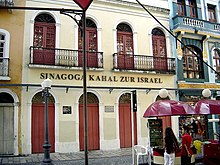
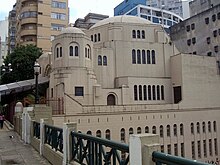
The first Jews arrived in Brazil as cristãos-novos (New Christians) or conversos, names applied to Jews or Muslims who converted to Catholicism, most of them forcibly. According to the Inquisition reports, many New Christians living in Brazil during colonial times were condemned for secretly observing Jewish customs.[42]
In 1630, the Dutch conquered portions of northeast Brazil and permitted the open practice of any religion. Many Jews came from the Netherlands to live in Brazil in an area dominated by the Dutch. Most of them were descendants of the Portuguese Jews who had been expelled from Portugal in 1497. In 1636, the Kahal Zur Israel Synagogue, the first synagogue in the Americas was built in Recife, the capital of Dutch Brazil.[42] The original building remains to this day,[43] but the Jews were forced to leave Brazil when the Portuguese-Brazilians retook the land in 1654.[44]
The first Jews that stayed in Brazil and openly practiced their religion came when the first Brazilian constitution granted freedom of religion in 1824, just after the independence. They were mainly Moroccan Jews.
The first wave of Sephardic Jews was exceeded by the larger wave of immigration by Ashkenazi Jews that came at the end of the 19th and beginning of the 20th centuries, mainly from Russia, Poland, Belarus and Ukraine. A final significant group came, fleeing Nazism or the destruction that followed World War II.
Brazil has the second-largest Jewish population in Latin America of 120,000 people, making up a total of 0.06% of Brazil's population.[45] As of 2017, Rio de Janeiro's Jewish population was 22,000, with 24 active synagogues and São Paulo has a Jewish population of 44,000.[45]

Islam
[edit]By Pew in 2010, there are 204,000 Muslims in Brazil, representing 0.1% of the total population.[46] The Federation of Muslim Associations of Brazil estimates there are about 1.5 million Muslims and others say about 400,000 to 500,000. There are over 150 mosques where Muslims perform their daily prayers.
Islam in Brazil may be presumed to have first been practiced by African slaves brought from West Africa. Scholars note that Brazil received more enslaved Muslims than anywhere else in the Americas.[47] During Ramadan, in January 1835, a small group of black slaves and freedmen from Salvador da Bahia, inspired by Muslim teachers, rose up against the government in the Malê Revolt, the largest slave rebellion in Brazil. (Muslims were called malê in Bahia at this time, from Yoruba image that designated a Yoruba Muslim.) Fearing the example might be followed, the Brazilian authorities began to watch the malês very carefully and in subsequent years intensive efforts were made towards conversions to Catholic Christianity and erase the popular memory of and affection towards Islam.[48] However, the African Muslim community was not erased overnight, and as late as 1910 it is estimated there were still some 100,000 African Muslims living in Brazil.[49]
A recent trend has been the increase in conversions to Islam among non-Arab citizens.[50]
Hinduism
[edit]Most of the Brazilian Hindus are ethnic East Indians. However, there are new converts due to the missionary effects of Hare Krishnas.
There are as many as 1500 PIOs in the Indian community in Brazil, and only 400 NRIs since foreign nationals can acquire local citizenship without any discrimination after 15 years of domicile in this country. Brazil has also no bar against dual citizenship. But in recent years, it has been granting immigration visas only in high technology fields. The only exceptions are the Sindhis in Manaus (who have formed an Indian Association with about a hundred members) and the Goans in São Paulo.
Besides the PIOs, there are Hindu organizations such as ISKCON as well as Brahma Kumaris which are very active in Brazil. The number of adherents of these organizations is not officially recorded but is estimated to be a few thousand. The Vedic Astrology, vedanga of Hinduism, is increasingly popular in Brazil, especially by the efforts of the Academia Brasileira de Astrologia Védica (ABAV) which promotes this branch of the Vedic culture in the country.
Positivist Church of Brazil
[edit]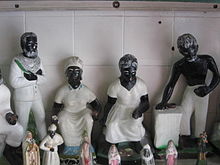
Many confuse Spiritism with Afro-Brazilian Religions like Umbanda, Candomblé, and others that have a following of almost 600,000 adherents. One of the most unusual features of the rich Brazilian spiritual landscape are the sects that use ayahuasca (an Amazonian entheogenic tea), including Santo Daime, União do Vegetal, and Centro de Cultura Cósmica. This syncretism, coupled with ideas prevalent during the military dictatorship, has resulted in a church for the secular, based on philosopher Auguste Comte's principles of positivism, based at the Positivist Church of Brazil in Rio de Janeiro. [citation needed]
Baháʼí Faith
[edit]The Baháʼí Faith in Brazil started in 1919 with Baháʼís first visiting the country that year,[51] and the first Baháʼí Local Spiritual Assembly in Brazil was established in 1928. There followed a period of growth with the arrival of coordinated pioneers from the United States finding national Brazilian converts and in 1961 an independent national Baháʼí community was formed. During the 1992 Earth Summit, which was held in Brazil, the international and local Baháʼí community were given the responsibility for organizing a series of different programs, and since then the involvement of the Baháʼí community in the country have continued to multiply. The Association of Religion Data Archives (relying on World Christian Encyclopedia) estimated some 42,100 Baháʼís in Brazil in 2010.[52]
Japanese New Religions
[edit]There are, in Brazil, many followers of Japanese new Religions like Oomoto, PL Kyodan, Seicho-no-Ie and the Church of World Messianity. The total number of adherents, if merged, maybe in the hundreds of thousands. [citation needed]
Beliefs
[edit]A 2009 poll, made by Datafolha and published in newspaper Folha de S. Paulo, asked diverse questions about the beliefs of the Brazilian people. In this poll, 64% reported to be Catholics, 17% Pentecostal Protestants, 5% non-Pentecostal Protestants, 3% Kardecists or Spiritists, 3% followers of other religions, 7% non-religious or atheists. Less than 1% reported to follow Afro-Brazilian religions.[53][54][55]
- Belief in God and the Devil
- 97% of Brazilians reported believing in God; 2% have doubts and 1% do not believe in God.
- 75% reported believing in the Devil, 9% have doubts and 15% do not believe in the Devil.
- 81% of those non-religious reported believing in God.
- About Jesus Christ
- 93% Reported they believe Jesus Christ rose after death; 92% that the Holy Spirit exists; 87% in the occurrence of miracles; 86% that Mary gave birth to Jesus as a virgin; 77% that Jesus will return to Earth at the end of time; 65% that the sacramental bread is the body of Jesus; 64% that after death some people go to Heaven; 58% that after death some people go to Hell and 60% that there is life after death.
- Belief in saints
- 57% Believe there are saints.
- 49% Pray for the intercession of a saint (68% among self-declared Catholics).
- 18% Pray for the intercession of Our Lady of Aparecida (26% among Catholics); Saint Anthony, Saint Expeditus (5% each), Saint George (3%), Saint Jude, Saint Francis of Assisi and Saint Joseph (2% each).
- About the Catholic priests
- 51% Believe some priests respect chastity, 31% most, 8% none, and 4% they all do.
- 66% That priests should be allowed to marry (59% among Catholics and 94% among followers of Candomblé).
- About the sexual abuse scandals involving priests, 38% believe some of the complaints are true, 30% most are, 21% all are and 4% none of them.
- About different religions
- About the sentence "Catholics do not practice their religion", 19% reported agreeing completely and 41% agreed, but not completely.
- About the sentence "the Protestants are misled by their priests", 61% agreed (77% among the Kardecists, 67% among Catholics and 45% among Protestants).
- About the sentence "Umbanda is a Devil thing", 57% agreed (83% among Evangelical Protestants, 53% among Catholics and 12% among Umbandists).
- About the sentence "Jews only think about money", 49% agreed. 51% disagreed.
- About the sentence "Muslims advocate terrorism", 49% agreed. 51% disagreed.
Freedom of religion
[edit]In 2023, the country was scored 4 out of 4 for religious freedom;[56] it was noted Afro-Brazilian religious groups face considerable discrimination and violence.
Regional data
[edit]| Region | Catholic (%) | Protestant (%) | Spiritism (%) | Afro-Brazilian religion (%) | Other (%) | Irreligion (%) | Asian religions (%) |
|---|---|---|---|---|---|---|---|
| 85.1 | 9.7 | 0.3 | 0.1 | 1.4 | 3.4 | 0.0 | |
| 79.2 | 9.9 | 0.5 | 0.1 | 6.5 | 4.7 | 0.1 | |
| 78.8 | 14.6 | 0.6 | 0.0 | 1.8 | 4.0 | 0.2 | |
| 77.0 | 15.1 | 0.6 | 0.1 | 1.4 | 5.7 | 0.1 | |
| 76.4 | 11.8 | 1.1 | 0.2 | 1.9 | 8.1 | 0.5 | |
| 76.0 | 15.4 | 0.8 | 0.0 | 1.4 | 10.4 | 0.0 | |
| 74.5 | 17.2 | 0.2 | 0.0 | 1.5 | 6.3 | 0.3 | |
| 73.1 | 20.0 | 1.2 | 0.2 | 1.8 | 3.3 | 0.4 | |
| 70.4 | 20.2 | 2.1 | 0.0 | 2.3 | 3.9 | 1.1 | |
| 68.8 | 18.3 | 3.2 | 1.5 | 2.3 | 5.3 | 0.6 | |
| 68.3 | 23.0 | 0.2 | 0.0 | 2.2 | 5.9 | 0.4 | |
| 67.7 | 22.2 | 1.0 | 0.0 | 2.6 | 4.6 | 2.9 | |
| 65.9 | 20.3 | 1.4 | 0.1 | 1.8 | 10.4 | 1.7 | |
| 65.2 | 17.4 | 1.1 | 0.3 | 4.0 | 12.0 | 0.0 | |
| 64.6 | 22.2 | 2.0 | 0.1 | 3.1 | 8.0 | 2.2 | |
| 63.7 | 25.8 | 0.4 | 0.1 | 2.1 | 7.0 | 0.9 | |
| 63.5 | 28.0 | 0.4 | 0.0 | 2.3 | 5.5 | 0.3 | |
| 63.4 | 24.5 | 1.3 | 0.1 | 3.0 | 6.6 | 1.1 | |
| 60.1 | 24.1 | 3.3 | 0.3 | 4.1 | 5.1 | 3.0 | |
| 58.8 | 28.1 | 2.5 | 0.0 | 2.5 | 8.1 | 0.0 | |
| 58.3 | 31.2 | 0.4 | 0.0 | 2.9 | 6.0 | 1.2 | |
| 57.4 | 26.5 | 1.9 | 0.0 | 3.0 | 9.2 | 2.0 | |
| 56.6 | 25.8 | 3.5 | 0.2 | 3.7 | 9.2 | 1.0 | |
| 52.2 | 33.1 | 1.0 | 0.2 | 2.0 | 10.4 | 1.1 | |
| 51.9 | 32.7 | 0.6 | 0.0 | 2.9 | 11.8 | 0.1 | |
| 47.9 | 30.3 | 0.9 | 0.1 | 6.6 | 13.0 | 1.2 | |
| 47.6 | 33.8 | 0.6 | 0.0 | 3.7 | 13.3 | 1.0 | |
| 45.8 | 29.4 | 4.0 | 0.9 | 4.3 | 14.6 | 1.0 |
See also
[edit]- Demographics of Brazil
- Roman Catholicism in Brazil
- Protestantism in Brazil
- The Church of Jesus Christ of Latter-day Saints in Brazil
- Islam in Brazil
- Judaism in Brazil
- Baháʼí Faith in Brazil
- Hinduism in Brazil
- Buddhism in Brazil
- Religion in Latin America
Pie Chart notes
[edit]- ^ Does not include the Brazilian Catholic Apostolic Church, which broke away from Rome in 1945.
References
[edit]- ^ a b c d e IBGE – Instituto Brasileiro de Geografia e Estatística (Brazilian Institute for Geography and Statistics). 2010 Census. Retrieved 7 August 2012.
- ^ "2010 Population Census - General characteristics of population, religion, and persons with disabilities (Portuguese)". ibge.gov.br (in Portuguese). 16 November 2012. Archived from the original on 16 November 2012. Retrieved 10 August 2019.
{{cite web}}: CS1 maint: unfit URL (link) - ^ - 50% dos brasileiros são católicos, 31%, evangélicos e 10% não têm religião, diz Datafolha. 2020 Retrieved February 7, 2022.
- ^ a b "Brazil". Berkley Center for Religion, Peace, and World Affairs. Retrieved 12 December 2011.
- ^ "50% dos brasileiros sao catholicos, 31%, evangelicos e 10% nao tem religiao" says Datafolha, Politca, globo.com, 2020
- ^ "Nordeste e Sul são últimos 'bastiões' católicos do Brasil". G1. 29 June 2013. Retrieved 3 June 2020.
- ^ Carneiro, Júlia Dias (29 June 2012). "Nordeste e Sul são últimos 'bastiões' católicos do Brasil". BBC Brazil. Retrieved 3 June 2020.
- ^ a b "Transição religiosa no Brasil: 1940-2032".
- ^ a b "As evangelicals gain, Catholics on verge of losing majority in Brazil". National Catholic Reporter. 5 February 2020.
- ^ Astor, Michael (1 January 2005). "Once-Barred Practice Flourishes in Brazil. African-Influenced Candomble Challenged by Pentecostals, Modern Interpretations". The Washington Post. Retrieved 5 February 2022.
- ^ "Decreased the number of Catholic and African religions. Increased the number of Protestants (Census 2000)".
- ^ Somer Wiggins. Followers of Brazil’s Umbanda religion worship despite discrimination. July 2, 2012. McClatchy. Accessed August 8, 2012.
- ^ IBOPE - Instituto Brasileiro de Opinião e Estatística. Pesquisa de Opinião Pública sobre Criacionismo. Dec. 2004. Accessed 2008-11-03
- ^ "Constituição". www.planalto.gov.br (in Brazilian Portuguese). 1988. Archived from the original on 20 August 2023. Retrieved 22 August 2023.
- ^ IBGE - Instituto Brasileiro de Geografia e Estatística (Brazilian Institute for Geography and Statistics). 2000 Census. Accessed 2007-04-24
- ^ "Folha Online - Mundo - Estagnação econômica explica recuo do catolicismo no Brasil, diz FGV - 20/04/2005". www1.folha.uol.com.br.
- ^ IBGE - Instituto Brasileiro de Geografia e Estatística (Brazilian Institute for Geography and Statistics). Notícias - Estudo revela 60 anos de transformações sociais no país. Accessed 2008-11-03.
- ^ Patrícia Birman, and Márcia Pereira Leite. "Whatever Happened to What Used to Be the Largest Catholic Country in the World?" Daedalus (2000) 129#2 pp. 271-290 in JSTOR
- ^ "Folha de S.Paulo. 64% dos brasileiros se declaram católicos".
- ^ "G1 > Brasil - NOTÍCIAS - Em 60 anos, Brasil ficou mais mestiço, evangélico e 'casado'". g1.globo.com.
- ^ https://www.ipsos.com/sites/default/files/ct/news/documents/2023-05/Ipsos%20Global%20Advisor%20-%20Religion%202023%20Report%20-%2026%20countries.pdf. Retrieved 6 October 2024.
{{cite web}}: Missing or empty|title=(help) - ^ 2022 Service Year Report of Jehovah’s Witnesses Worldwide
- ^ "Brasil: Cronologia da Igreja". www.churchofjesuschrist.org (in Portuguese). Retrieved 26 June 2024.
- ^ Magalhães, Leandro. "Comunidade mórmon cresce no Brasil e ganha novo templo em Brasília". CNN Brasil. Retrieved 6 June 2024.
- ^ "Fatos e Estatísticas".
- ^ "Lista de templos | A Igreja de Jesus Cristo dos Santos dos Últimos Dias". www.churchofjesuschrist.org. Retrieved 26 June 2024.
- ^ "Fatos e Estatísticas — Sala de Imprensa". noticias-br.aigrejadejesuscristo.org (in Portuguese). Retrieved 26 June 2024.
- ^ A Igreja de Jesus Cristo dos Santos dos Últimos Dias. "O que Acontece nos Templos". Retrieved 11 August 2013.
- ^ Thomas S. Monson (June 1992). "As Bênçãos do Templo". Retrieved 11 August 2013.
- ^ A Igreja de Jesus Cristo dos Santos dos Últimos Dias. "Qual é a diferença entre frequentar a capela e o templo?". Retrieved 11 August 2013.
- ^ "Mapas". maps.churchofjesuschrist.org. Retrieved 26 June 2024.
- ^ "Propósito de Mãos Que Ajudam". noticias-br.aigrejadejesuscristo.org (in Portuguese). 26 July 2012. Retrieved 26 June 2024.
- ^ "'Mãos que Ajudam' promove ação para a inclusão das pessoas com deficiência no mercado de trabalho". G1 (in Brazilian Portuguese). 9 September 2023. Retrieved 26 June 2024.
- ^ "A Igreja de Jesus Cristo foi restaurada". www.churchofjesuschrist.org (in Portuguese). Retrieved 26 June 2024.
- ^ "Restauracionismo – Igreja de Jesus Cristo e Testemunhas de Jeová". www.searaagape.com.br. Retrieved 26 June 2024.
- ^ "Restauracionismo". Wikipédia, a enciclopédia livre (in Portuguese). 5 April 2024. Retrieved 26 June 2024.
- ^ "Relacionamento entre as Religiões". noticias-pt.aigrejadejesuscristo.org (in Portuguese). 22 March 2012. Retrieved 26 June 2024.
- ^ "Regras Sobre Tolerância". Thomas S. Monson. 10 February 2013. Retrieved 26 June 2024.
- ^ a b Neo-Pentecostalism and Afro-Brazilian religions: explaining the attacks on symbols of the African religious heritage in contemporary Brazil. Translation from: Mana, Rio de Janeiro, v.13 n.1, p. 207-236, Apr. 2007.
- ^ Phillips, Dom (6 February 2015). "Afro-Brazilian religions struggle against Evangelical hostility". The Washington Post. Retrieved 5 February 2022.
- ^ Moreira-Almeida, Alexander (2008). Allan Kardec and the development of a research program in psychic experiences
- ^ a b Oreck, Alden. The Virtual Jewish History Tour: Brazil. Jewish Virtual Library. Accessed 2008-06-09
- ^ Synagogue in Brazilian town Recife considered oldest in the Americas. Haaretz 2007-11-12. Accessed 2008-06-09
- ^ Friedman, Saul. Jews and the American Slave Trade, p. 60. Transaction Publishers, 1997. ISBN 0-7658-0660-6
- ^ a b "The Jewish Community in Brazil". Beit Hatfutsot. Retrieved 12 March 2020.
- ^ "Table: Muslim Population by Country". Pew Research Center's Religion & Public Life Project. 27 January 2011. Retrieved 10 July 2021.
- ^ Lovejoy, Paul E., Muslim Encounters With Slavery in Brazil, Markus Wiener Pub., 2007. ISBN 1-55876-378-3.
- ^ Joao Jose Reis, Slave Rebellion in Brazil: The Muslim Uprising of 1835 in Bahia, Johns Hopkins University Press, London 1993
- ^ Steven Barboza, American Jihad, 1993
- ^ "Bureau of Democracy, Human Rights, and Labor International Religious Freedom Report 2009" October 26, 2009, US Department of State report on Brazil
- ^ Lamb, Artemus (November 1995). The Beginnings of the Baháʼí Faith in Latin America: Some Remembrances, English Revised and Amplified Edition. West Linn, OR: M L VanOrman Enterprises.
- ^ "QuickLists: Most Baha'i Nations (2010)". Association of Religion Data Archives. 2010. Retrieved 15 October 2020.
- ^ Data Folha - Opinião Pública. 64% dos brasileiros se declaram católicos 2007-05-05. Accessed 200-11-03
- ^ "Renascença - A par com o mundo". Rádio Renascença.
- ^ "Notícias Gospel - Home". Notícias Gospel.
- ^ Freedom House website, retrieved 2023-08-08
- ^ «Censo 2010». IBGE
- ^ «Análise dos Resultados/IBGE Censo Demográfico 2010: Características gerais da população, religião e pessoas com deficiência» (PDF)
